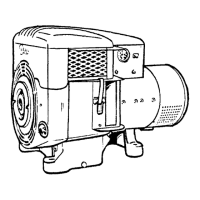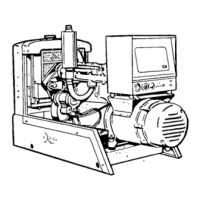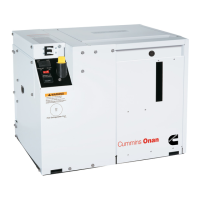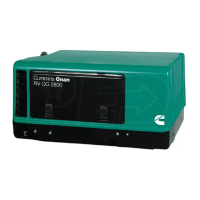NO
LOAD
OPERATION
Periods of no load operation should be held to a
minimum.
If it is necessary to keep theengine running
for long periods of time when no electric output is
required,
best engine performance will be obtained
by connecting a "dummy" electrical load.-Such a load
could consist of heater elements, etc.
HIGH
TEMPERATURES
1.
See that nothing obstructs air flow to-and-from
the set.
2.
Keep cooling system clean.
3. Use correct SAE No. oil for temperature
con-
ditions.
OUT-OF-SERVICE
PROTECTION
Protect a set that will be out-of-service for more than
30 days as follows:
1.
Run set until thoroughly warm.
2.
Drain oil from oil base while still warm. Refill and
attach a warning tag stating oil viscosity used.
3. Remove each injector. Pour 1 ounce (two
tablespoons) of rust inhibitor (orSAE#10oil) into
each cylinder. Crank engine over several times.
Install injectors.
4.
Service air cleaner
LOW
TEMPERATURES
1.
Use correct SAE No. oil for temperature
con-
ditions. Change oil only when engine is warm.
2.
Use fresh
fuel.
Protect against moisture conden-
sation.
3. Keep fuel system-clean and batteries in a well
charged condition.
4.
Partially restrict cool airflow butusecareto avoid
overheating.
5. Connect water jacket heater when set is not
running.
6. Refer to John Deere manual for further informa-
tion.
5. Clean throttle linkage and protect by wrapping
with a clean cloth.
6. Plug exhaust outlets to prevent entrance of
- moj stu
re,
bugs, dirt, etc.
7. Wipe-'entirexunit. Coat parts susceptible to. rust
with a light ftlnrrof grease or oil."
8. Disconnect battery and follow stahdard
r
batfery'
storage procedure.
9. Provide a suitable cover for the entire unit.
10.
See engine operation and maintenance manual.
Water Jacket Heater: The function of this optional
heater is to keep the engine-warm enough to assure •
startingfunder adverse weather-xondilions. Connect"
the heater to a source of power that wilLbe on during
JT.
the time the engine is not running. Be sure the voltage
rating is correct for the heater element rating (Figure
19).
HIGH
ALTITUDE
Ratings apply to altitudes up to 1000 feet, standard
cooling,
normal ambients and with No. 2 Diesel
fuel.
Consult factory or nearest authorized Onan dis-
tributor for operating characteristics under other
conditions.
Engine horsepower loss is approximately 3 percent lor each 1000
feet of altitude above sea level for a naturally aspirated engine. Use
lower power requirement at high altitudes to prevent smoke, over-
fueling and high temperatures.
LINE
208 OR 240 V., 20A I 0
BLACK•
• WHITE
-GND
' (GREEN)
OUTLET
INLET |
FIGURE 19. ENGINE HEATER
22

